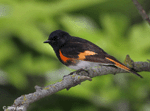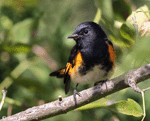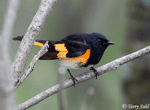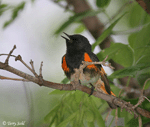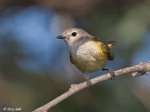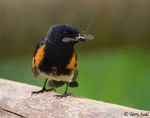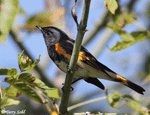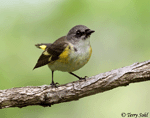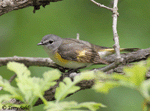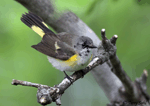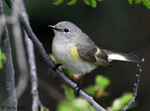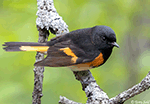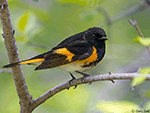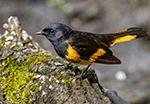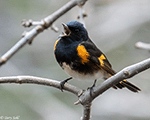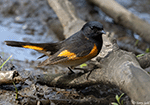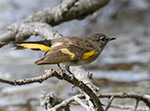American Redstart
Setophaga ruticilla
| Length: 5 inches | Wingspan: 8 inches | Seasonality: Summer / Migrant |
| ID Keys: Male black with orange-red patches on wings, tail, and sides. Female plainer with yellow wing and tail patches. | ||
 American Redstarts are one of the most common
warblers to breed in the United States, including in South Dakota. They are more
easily observed than many warbler species in South Dakota, given their tendency
to often forage relatively low in forest undergrowth or along the forest floor.
They are an extremely active species, not only moving from spot to spot as they
forage, but constantly shifting body position and fanning the tail (particularly
the males).
American Redstarts are one of the most common
warblers to breed in the United States, including in South Dakota. They are more
easily observed than many warbler species in South Dakota, given their tendency
to often forage relatively low in forest undergrowth or along the forest floor.
They are an extremely active species, not only moving from spot to spot as they
forage, but constantly shifting body position and fanning the tail (particularly
the males).
Habitat:
Prefers edges and clearings of deciduous to mixed forest, also riparian areas and isolated groves.
Diet:
Mostly insects, occasionally fruits and berries, seeds.
Behavior:
Extremely active while foraging, flitting from location to location, actively clambering over vegetation and flying out to catch insects. American Redstarts are known for frequent tail fanning while foraging.
Nesting:
June and July in South Dakota. The nest of an American Redstart is a small cup, constructed of grasses, weed stems, leaves, animal hair, small roots and other bits of vegetation, and is generally lined with fine grasses and animal hair. The nest is placed in a tree or shrub, usually between 8 and 20 feet from the ground. The female lays 2 to 5 eggs, and she alone incubate them. The young hatch after about 12 days, and fledge from the nest about 10-13 day after hatching.
Interactive eBird Map:
Click to access an interactive eBird map of American Redstart sightings
Song:
The song of an American Redstart is a series of thin, rapid chew-chew-chew notes. Both males and females have a variety of different call notes, from single chip notes to multi-syllable calls.
1Click here to hear the song of an American Redstart
2Click here to hear the call of an American Redstart
3Click here to hear short chip calls of an American Redstart
Migration:
Neotropical migrant, summering in the eastern and northern U.S. and Canada, wintering in Mexico, Central America, and South America.
Similar Species:
American Redstarts are generally distinctive if seen well, especially males. Given the general paucity of bird species here with predominantly black and orange plumage, the bird most likely to be confused with an American Redstart at first glance may be the Baltimore or Bullock's Oriole in South Dakota. Differences are apparent when seen well however, as both Oriole species are much larger than an American Redstart, have orange on the belly instead of white, and have a substantially larger bill. Behavior also distinguishes them, as American Redstarts are often relatively low in vegetation, with a distinctive, very active foraging pattern that includes frequent fanning of the tail while moving about.
Conservation Status:
Standard surveys such as the Breeding Bird Survey show small population declines in recent decades. However, they are found across and extremely broad geographic range, and their numbers are quite high in many parts of that range. The IUCN considers the American Redstart to be a species of "Least Concern".
Further Information:
1) BirdWeb - American Redstart
2) WhatBird - American Redstart
3) Audubon Guide - American Redstart
Photo Information:
June 3rd, 2007 - Newton Hills State Park in South Dakota -- Terry Sohl
Additional Photos:
Click on the image chips or text links below for additional, higher-resolution American Redstart photos.
Audio File Credits:
1Anthony Gliozzo. Recorded in Washington State on May 30th, 2019. Original recording and information from xeno-canto.
2William Whitehead. Recorded in Monmouth County, New Jersey on May 4th, 2018. Original recording and information from xeno-canto.
3Ross Gallardy. Recorded in Jamaica on March 9th, 2016. Original recording and information from xeno-canto.
| Click on the map below for a higher-resolution view |
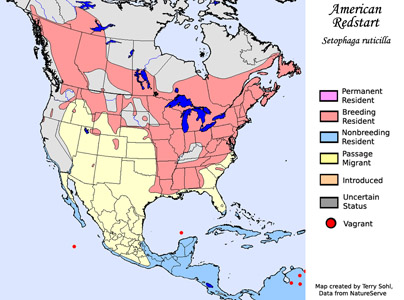 |
| South Dakota Status: Common migrant throughout the state. Common breeder in the western part of the state, uncommon in the southeast and northeast corners of the state. |
Additional American Redstart Photos
Click for a higher-resolution version of these photos
